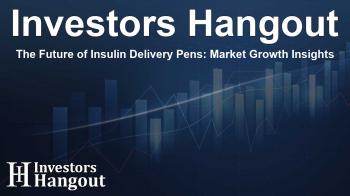The Future of Insulin Delivery Pens: Market Growth Insights

Market Growth of Insulin Delivery Pens
The global insulin delivery pens market is witnessing an exciting trajectory as it is expected to grow significantly. Currently valued at USD 26,412 million, it is projected to soar to USD 58,086 million by 2034, driven by a robust compound annual growth rate (CAGR) of 8.2% from 2025 to 2034. This growth can be attributed to several factors, including technological advancements, increasing diabetes prevalence, and a growing senior population.
Understanding Insulin Delivery Pens
Insulin delivery pens are innovative devices that offer a user-friendly approach to insulin administration, combining the functions of a syringe and medication into one streamlined unit. These pens are prefilled with insulin, eliminating the need for separate syringes and vials, which adds convenience, especially for users who have difficulty managing multiple components. Recent studies have revealed that insulin pens enhance dosing consistency and accuracy compared to traditional syringes, ultimately providing better care for patients with diabetes.
Technological Innovations
Many advancements in insulin delivery pens are driving market growth. For instance, smart insulin pens now connect to mobile applications, allowing users to track their insulin usage, receive alerts for missed doses, and manage their diabetes more effectively. These apps can even monitor factors such as insulin temperature and expiration dates. Such innovations are set to revolutionize diabetes management.
Market Segmentation and Insights
The insulin delivery pens market can be segmented into various categories based on product type, technology, and distribution channels. As of 2024, disposable insulin pens hold the largest market share, favored for their safety and ease of use. However, the reusable insulin pens segment is anticipated to exhibit the fastest growth rate during the forecast period, thanks to their environmental sustainability and cost-effectiveness.
Key Market Trends
Several key trends are shaping the insulin delivery pens market. Increased diabetes care spending is one such trend, as studies indicate that a significant portion of individuals with diabetes allocate substantial portions of their income to manage their condition. Furthermore, government initiatives aimed at improving health insurance coverage for insulin are paving the way for broader access to quality diabetic care.
Challenges Facing the Market
Despite its promising growth, the insulin delivery pens market faces certain challenges. Stringent government regulations can impede access to these devices, potentially leading to increased costs and delayed innovations. Additionally, the high price of insulin and alternative insulin delivery methods continue to pose concerns for patients and healthcare providers alike.
Regional Analysis: North America Dominates
As of 2024, North America commands the largest share of the insulin delivery pens market. The region is experiencing a high rate of diabetes prevalence driven by sedentary lifestyles and an aging population. Innovative product launches, such as the recent Omnipod 5 automated insulin delivery system, further bolster market growth.
Future Prospects in the Asia Pacific Region
Looking ahead, the Asia Pacific region is projected to be the fastest-growing market for insulin delivery pens. Factors including increasing urbanization, rising diabetes cases, and growing demand for advanced healthcare solutions are expected to drive this growth in the coming years. Countries like India and Japan are emerging as key players in this market, with substantial advancements in diabetes treatment options.
Conclusion: A Bright Future
The future of the insulin delivery pens market looks bright as it adapts to the evolving needs of diabetes management. With continuous technological advancements, rising awareness, and increasing healthcare investment, this market is set to expand significantly over the coming years. Companies in this sector must focus on innovation and patient education to remain competitive.
Frequently Asked Questions
What is the projected growth rate of the insulin delivery pens market?
The insulin delivery pens market is projected to grow at a CAGR of 8.2% from 2025 to 2034.
What are the main advantages of using insulin delivery pens?
Insulin delivery pens are user-friendly, improve dosing consistency, and enhance patient satisfaction compared to traditional syringes.
Why is North America the leading market for insulin delivery pens?
North America has the highest diabetes prevalence and access to advanced technologies, making it the largest market.
What challenges does the insulin delivery pen market face?
Challenges include stringent regulations, high costs of insulin, and competition from alternative delivery methods.
How is technology shaping the future of insulin delivery pens?
Innovative features like smart technology and app connectivity are transforming diabetes management, enhancing user experience.
About The Author
Contact Logan Wright privately here. Or send an email with ATTN: Logan Wright as the subject to contact@investorshangout.com.
About Investors Hangout
Investors Hangout is a leading online stock forum for financial discussion and learning, offering a wide range of free tools and resources. It draws in traders of all levels, who exchange market knowledge, investigate trading tactics, and keep an eye on industry developments in real time. Featuring financial articles, stock message boards, quotes, charts, company profiles, and live news updates. Through cooperative learning and a wealth of informational resources, it helps users from novices creating their first portfolios to experts honing their techniques. Join Investors Hangout today: https://investorshangout.com/
The content of this article is based on factual, publicly available information and does not represent legal, financial, or investment advice. Investors Hangout does not offer financial advice, and the author is not a licensed financial advisor. Consult a qualified advisor before making any financial or investment decisions based on this article. This article should not be considered advice to purchase, sell, or hold any securities or other investments. If any of the material provided here is inaccurate, please contact us for corrections.

